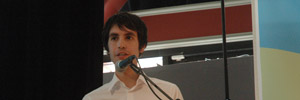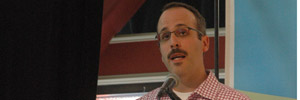Design 2.0: Closing thoughts

This is it, we’ve reached the end of my Design 2.0 write-up. To conclude, let me offer up some of my own thoughts on the conference. I’ll start by saying that this was the first design conference I attended, and I had a great time. I particularly enjoyed Diego’s and Steve’s talks, and got a chance to meet some really cool people during the mixer. Overall, the conference was definitely a success as far as I’m concerned.
Nevertheless, I think we all missed an opportunity to explore a very interesting topic. While the talks were entertaining, I found them overly broad, and only tenuously related to the theme. I wish there had been more parallels drawn with the natural world. I touched on this in my audience question about the fragility of ecosystems, but I had dozens more in the same vein. I wanted to be told about predators and parasites, evolution and natural disasters. How can our knowledge of natural ecosystems inform our decisions in product ecosystems? And how do product systems differ from natural systems?
I would also have liked to hear more real world examples and applicable lessons. Tell me about challenges posed by specific product ecosystems, how a given product succeeded within its ecosystem or how another one failed and why (and please, please don’t ever tell me about the iPod again). Also tell me about the research methods of people studying ecosystems: biologists, anthropologists, sociologists, and so forth. Expand my design toolkit, teach me how to think about my product in context. Many of these points were touched on, but ever so briefly and with very little substance.
If I had to sum it up in one sentence, I’d say it was a fine conference but that it didn’t really address the topic – and that’s a pity given the potential of the theme.
PS: If I hear one more vague question about “the social role of designers”, I’m going to have a hissy-fit. Consider yourselves lucky that I filtered the Q&A for you.













